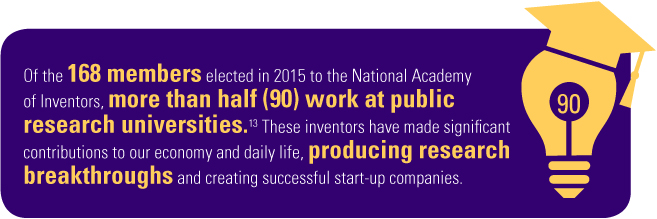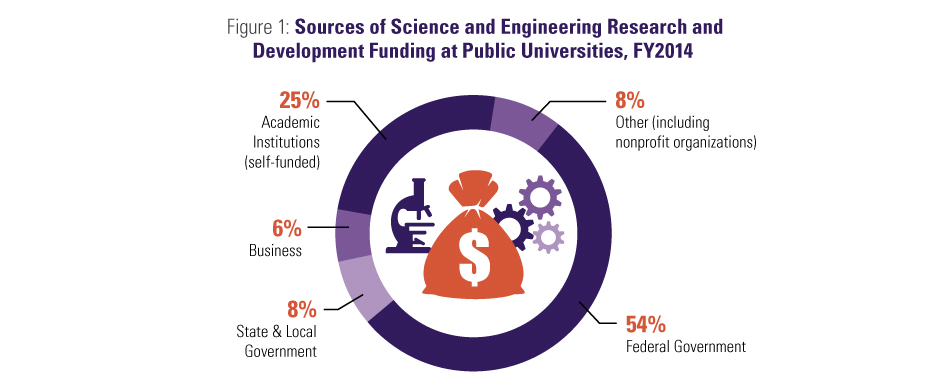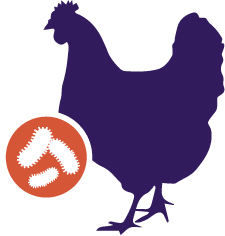Section 1: Public Research Universities are Centers of Discovery
Public research universities are responsible for conducting much of the nation’s core research in science, medicine, engineering, and technology. During and after World War II, the nation’s federal research and development was performed primarily by national laboratories and industrial research laboratories, including those supported by Bell Telephone, Xerox, and Hewlett Packard. But many of these great industrial laboratories have since shut their doors, and American companies have formed partnerships with research universities to fill the gap.6
The discoveries made by researchers at public research universities have significantly advanced our shared knowledge and improved the health and lives of the public. In all, scientists at public research universities have been awarded fifty-three Nobel Prizes in Physics, Chemistry, and Physiology or Medicine, and fifteen Nobel Prizes in Economic Sciences.7 Each public research university can claim breakthroughs made on its campus that have improved health, enhanced quality of life, and advanced new industries:
- Important antibiotics, including Streptomycin, were discovered at Rutgers University.8
- Life-saving safety devices, including retractable locking seatbelts, were created at the University of Minnesota.9
- The CRISPR gene editing system was coinvented by a researcher at University of California, Berkeley, receiving the 2015 Breakthrough of the Year Award from the editors of Science.10
- East Texas’s blueberry industry and increased watermelon production resulted from agricultural research conducted at Texas A&M University’s AgriLife Research center. The center’s research has an estimated regional economic impact of more than $1.2 billion.11
- The lithium-ion battery, a critical component of smartphones and tablets, was developed by faculty at the University of Texas at Austin.12
- Touch screens were developed at the University of Kentucky, and multi-scrolling capabilities originated at the University of Delaware.14
- Our social security system was developed using social science research conducted at the University of Wisconsin.15
- The advancement of modern industries based on information technology, nanotechnology, and biotechnology that drive our high-tech economy rely on basic research conducted at our public research universities.16

Reflecting their position in the nation’s research enterprise, public research universities receive more than half of all government, industry, and foundation investment in basic and applied research. In 2014, the combined expenditures of public and private universities on research and development (R&D) totaled $67.1 billion, of which $63.7 billion was spent in science and engineering fields.17 Public universities accounted for 66 percent ($44.7 billion) of all university R&D expenditures, and public research universities classified as Very High Research Activity accounted for 46 percent ($31.2 billion) of all R&D expenditures.18

|
Funding from Academic Institutions excludes research funds spent from multipurpose accounts. Distribution totals 101 percent due to rounding. Source: National Science Board, Science and Engineering Indicators 2016 (Arlington, Va.: National Science Foundation, 2016), Appendix Table 5–3, “Sources of S&E R&D Funding for Public and Private Academic Institutions: Selected Years, FYs 1990–2014,” http://www.nsf.gov/statistics/2016/nsb20161/uploads/1/8/at05-03.pdf.
A Case Study: Federally Funded University-Based Research on Food Safety
 There were approximately forty-eight million cases of food-borne illnesses in
2011, causing—according to conservative estimates—a $14
billion burden on the U.S. economy. In response, the U.S. Department of Agriculture
funded a pilot project headquartered at Georgia Institute of Technology to investigate what
food research is being done, where, by whom, and to what effect.19 The resulting data sets
show how research investments bring about new food safety measures, and the impact
that these innovations have on policies governing safe growth, processing, and distribution
of food. These connections also show the influence that research dollars have on
other outcomes, including student job placement, publication of research articles,
and number of patents filed.20
There were approximately forty-eight million cases of food-borne illnesses in
2011, causing—according to conservative estimates—a $14
billion burden on the U.S. economy. In response, the U.S. Department of Agriculture
funded a pilot project headquartered at Georgia Institute of Technology to investigate what
food research is being done, where, by whom, and to what effect.19 The resulting data sets
show how research investments bring about new food safety measures, and the impact
that these innovations have on policies governing safe growth, processing, and distribution
of food. These connections also show the influence that research dollars have on
other outcomes, including student job placement, publication of research articles,
and number of patents filed.20
Public Research Universities and the Grand ChallengesInspired by the White House Office of Science and Technology Policy’s 21st Century Grand Challenges program,21 public research universities are investing in research programs to address our planet’s most pressing problems.
|
ENDNOTES
6 American Academy of Arts & Sciences, Restoring the Foundation: The Vital Role of Research in Preserving the American Dream (Cambridge, Mass.: American Academy of Arts & Sciences, 2014).
7 Researchers were employed at public research universities at the time the award was given. See Nobel Prize, “Nobel Laureates and Research Affiliations,” http://www.nobelprize.org/nobel_prizes/lists/universities.html.
8 Rutgers Waksman Institute of Microbiology, “History,” https://www.waksman.rutgers.edu/about/history.
9 Steven John, “Ten Ways U Research Affects You,” Minnesota Public Radio, February 2001, http://news.minnesota.publicradio.org/projects/2001/02/universalu/topten/9_krations.html.
10 John Travis, “Making the Cut,” Science [2015 Breakthrough of the Year] 350 (6267): 1456–1457.
11 Texas A&M AgriLife Research, “Research Impacts,” http://agriliferesearch.tamu.edu/about-agrilife-research/research_impacts/.
12 Association of American Universities, “Riding the Wave of Federal Investment: How Federal Research Made the iPad Possible,” January 10, 2014, http://www.aau.edu/WorkArea/DownloadAsset.aspx?id=14900.
13 National Academy of Inventors, “NAI Fellows,” http://www.academyofinventors.org/fellows.asp.
14 Association of American Universities, “Riding the Wave of Federal Investment.”
15 U.S. Social Security Administration, “Agency History—Research Note #8: The Special Role of the University of Wisconsin in the History of Social Security,” https://www.ssa.gov/history/wiscrole.html.
16 Jonathan R. Cole, The Great American University: Its Rise to Preeminence, Its Indispensable National Role, Why It Must Be Protected (New York: Public Affairs, 2009), 205.
17 National Science Board, Science and Engineering Indicators 2016 (Arlington, Va.: National Science Foundation, 2016). Five percent of all R&D (about $3–4 billion) is spent on non–science and engineering projects, including business management, communications, journalism and library science, humanities, law, social work, and visual and performing arts.
18 National Science Foundation, National Center for Science and Engineering Statistics, Higher Education Research and Development Survey, Fiscal Year 2014, “Ranked by All R&D Expenditures.”
19 The USDA-funded research team at Georgia Tech University: Kaye Husbands Fealing, Georgia Tech; Sandra Hoffmann, U.S. Department of Agriculture; Stan Johnson, National Center for Food and Agricultural Policy; John L. King, University of California, Davis; Julia Lane, New York University; Christina Jones, American Institutes for Research; Yeong Jae Kim, Georgia Institute of Technology; and Evgeny Klochikin, American Institutes for Research.
20 UMETRICS@IRIS (Institute for Research on Innovation and Science). IRIS principal investigators include James Evans, University of Chicago; Julia Lane, NYU; Barbara McFadden Allen, CIC (Committee on Institutional Cooperation); Jason Owen-Smith, University of Michigan; and Bruce Weinberg, Ohio State University. Visit http://iris.isr.umich.edu/ for more information.
21 White House Office of Science and Technology Policy, “21st Century Grand Challenges,” https://www.whitehouse.gov/administration/eop/ostp/grand-challenges.
22 Indiana University, “Grand Challenges Program,” http://www.grandchallenges.iu.edu.
23 UC Office of the President, “UC Only University to Join Coalition Led by Bill Gates to Invest in Climate Solutions,” University of California, November 29, 2015, http://www.universityofcalifornia.edu/press-room/UC-only-university-join-coalition-led-bill-gates-invest-climate-solutions.
24 Michigan News, “U-Michigan Launches $100 Million Data Science Initiative,” September 8, 2015, http://www.ns.umich.edu/new/releases/23105-u-michigan-launches-100-million-data-science-initiative.
25 Texas A&M University College of Agriculture and Life Sciences, “The Grand Challenges,” http://grandchallenges.tamu.edu/home/; and Angel Futrell, “Grants Awarded and Mini-Symposia Selected for 2016,” Texas A&M University, January 25, 2016, http://grandchallenges.tamu.edu/2016/01/25/grants-awarded-and-mini-symposia-selected-for-2016/.
26 See the UCLA Institute for Society and Genetics at http://socgen.ucla.edu.